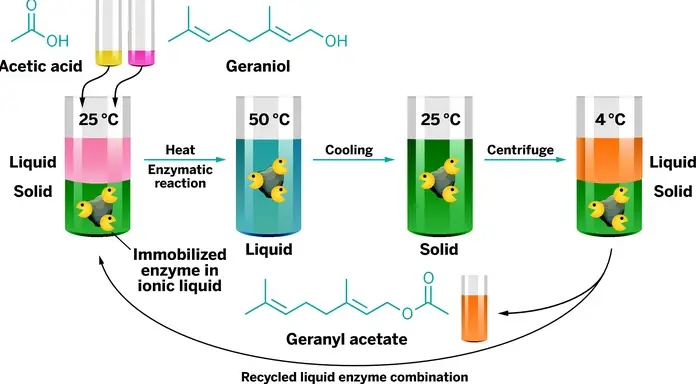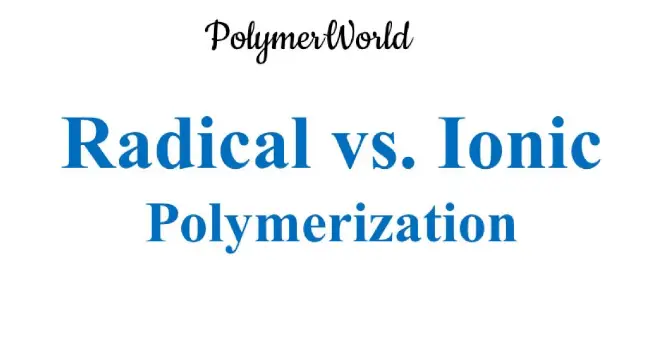Polymerization stands at the core of modern materials science, facilitating the creation of a vast array of polymers essential for various applications ranging from everyday household items to high-tech industrial materials. At the heart of this transformative process are two primary techniques: free radical and ionic polymerization. Each method employs distinct mechanisms and conditions, leading to different polymer structures and properties.
The key distinction between free radical and ionic polymerization lies in the nature of the species that initiates the polymerization process. Free radical polymerization is initiated by free radicals, which are highly reactive atoms or groups of atoms with unpaired electrons. In contrast, ionic polymerization can be either cationic or anionic, initiated by positively charged ions (cations) or negatively charged ions (anions), respectively. These differences significantly influence the reactivity, the structure of the polymers produced, and the conditions under which polymerization can successfully occur.
Free radical polymerization is known for its simplicity and tolerance to various types of monomers, making it widely applicable in manufacturing plastics and rubbers. On the other hand, ionic polymerization offers greater control over molecular weight and the polymer structure, crucial for creating high-performance materials with specific characteristics. Both methods have their advantages and limitations, making them suitable for different industrial applications.

Polymerization Basics
Definition of Polymerization
Polymerization is a chemical process that involves the linking together of molecules called monomers, forming a large, complex structure known as a polymer. This fundamental chemical reaction is the backbone of numerous industrial and manufacturing processes, which produce materials ranging from everyday plastic products to specialized high-performance items.
Key Types of Polymerization
There are several types of polymerization, each differing in mechanisms and the types of polymers they produce. The main categories include:
- Free Radical Polymerization
- Ionic Polymerization (which splits further into cationic and anionic)
- Condensation Polymerization
- Coordination Polymerization
Each type plays a crucial role depending on the desired properties of the final product, such as elasticity, strength, and chemical resistance.
Focus on Free Radical and Ionic Methods
The scope of this article narrows down to free radical and ionic polymerization, as these are pivotal in creating a wide array of polymers used across various industries.
Free Radical Polymerization
Overview of Free Radical Polymerization
Free radical polymerization is one of the most common methods used to produce polymers. It involves the reaction of monomers with free radicals, which are atoms or groups of atoms with an unpaired electron, making them highly reactive.
Mechanism Explained
The process of free radical polymerization can be broken down into three essential steps:
- Initiation: A free radical is generated, usually by the decomposition of a chemical initiator under heat or light.
- Propagation: The active radical reacts with a monomer, forming a new radical which then reacts with another monomer, creating a growing polymer chain.
- Termination: The reaction ends when two radical chains combine, a radical reacts with an inhibitor, or when a radical chain transfers its radical to a non-reactive site.
Common Initiators
Several substances can act as initiators for free radical polymerization; these include:
- Benzoyl peroxide
- Azobisisobutyronitrile (AIBN)
- Tert-butyl hydroperoxide
These initiators decompose upon heating to produce free radicals necessary to start the polymerization process.
Advantages and Limitations
Advantages:
- Simplicity and versatility in the choice of monomer and reaction conditions.
- High-speed reaction rates.
Limitations:
- Control over molecular weight is less precise.
- Susceptibility to oxygen inhibition, which can interfere with the curing process.
Ionic Polymerization
Overview of Ionic Polymerization
Unlike free radical polymerization, ionic polymerization involves the use of ionically charged initiators. This type can be split into two further categories: cationic, which uses positive ions, and anionic, which employs negative ions.
Types: Cationic and Anionic
Cationic Polymerization:
- Initiated by electrophiles (electron-loving species).
- Commonly used for producing polymers like polyisobutylene and cationic polyacrylamides.
Anionic Polymerization:
- Initiated by nucleophiles (nucleus-loving species).
- Frequently used for synthesizing polymers like polystyrene and polybutadiene.
Mechanism and Catalysts
Mechanism:
- Initiation: An ionically charged initiator reacts with a monomer to form an active center.
- Propagation: The active center reacts with additional monomer molecules to extend the polymer chain.
- Termination: Typically, termination in ionic polymerizations can be controlled or avoided, allowing for the synthesis of polymers with precise structures.
Catalysts:
- Cationic: Lewis acids like aluminum trichloride or ether complexes.
- Anionic: Alkali metals like sodium naphthalene.
Advantages and Limitations
Advantages:
- High precision in controlling molecular weight and polymer structure.
- Ability to produce living polymers, where the polymer chain growth can be restarted even after dormancy.
Limitations:
- Sensitive to moisture and impurities.
- Requires strict control of reaction conditions, limiting its versatility compared to free radical polymerization.
Comparison of Mechanisms
Initiation Process
The initiation phase is fundamentally different between free radical and ionic polymerizations. In free radical polymerization, the process begins with the generation of free radicals, usually through the decomposition of chemical initiators like benzoyl peroxide or AIBN in the presence of heat or light. These radicals are highly reactive due to their unpaired electrons and readily initiate the polymerization process by attacking monomer units.
In contrast, ionic polymerization relies on ionically charged initiators. Cationic polymerization starts with a positive ion attacking a monomer, typically driven by strong electrophiles such as Lewis acids. Anionic polymerization uses a negative ion, initiated by nucleophilic species, which may involve alkali metal organics like butyllithium. The choice of initiator in ionic polymerization is crucial, as it directly affects the polymer’s structure and properties.
Growth and Termination Stages
The growth stage in both types of polymerizations involves the sequential addition of monomer molecules to the active center of the growing chain. In free radical polymerization, the radical end of the polymer chain remains active throughout the process, allowing continuous addition of monomers. Termination occurs when two radical chains combine (coupling), when a chain transfers its radical to a non-reactive site, or when it reacts with an inhibitor.
Ionic polymerizations, however, do not typically involve a true termination step in the same way. Instead, the polymer chain remains active unless quenched intentionally or terminated by impurities or water. This characteristic allows for the resumption of polymerization upon the addition of more monomer or the removal of termination agents, leading to “living polymers.”
Influence of Solvent and Temperature
Solvent and temperature play critical roles in both types of polymerization. Solvents must be carefully selected to ensure solubility of the monomer and the polymer while not interfering with the active growing chain. Free radical polymerization is less sensitive to the type of solvent but is highly influenced by temperature, which affects the rate of initiator decomposition and thus the rate of polymerization.
Ionic polymerizations are extremely sensitive to the choice of solvent, as the solvent can interact with the charged species involved in the initiation and propagation phases. Temperature control is also critical, particularly in maintaining the stability of the ionic species and controlling the rate of polymerization.
Applications in Industry
Use in Plastic Manufacturing
Free radical polymerization is the backbone of the plastic manufacturing industry. It is used extensively to produce polymers like polyethylene, polystyrene, and PVC, which are fundamental to various consumer products, packaging, and construction materials. Its popularity stems from its simplicity and the ability to scale up economically.
Role in Creating Elastomers
Ionic polymerizations, particularly anionic, play a significant role in creating elastomers, such as butadiene rubber and styrene-butadiene rubber. These materials are crucial for the automotive industry, particularly in tire manufacturing, where properties like resilience and durability are essential.
High-performance Materials
Both polymerization methods contribute to the development of high-performance materials. Ionic polymerization, with its ability to create well-defined polymer architectures, is ideal for engineering advanced materials used in electronics, aerospace, and medical devices. These polymers often have unique electrical, mechanical, or chemical properties tailored for specific applications.
Recent Advances
Innovations in Catalyst Design
Recent years have seen significant advancements in catalyst design, particularly for ionic polymerizations. New catalysts have been developed that allow for more efficient, controlled, and environmentally friendly polymerizations. These innovations include the use of less toxic metals, the introduction of biodegradable catalysts, and the development of catalysts that can operate at lower temperatures, reducing energy consumption.
Controlled Polymer Architectures
Advances in controlling polymer architectures have been particularly prominent in ionic polymerization techniques. Researchers have developed methods to precisely control the size, shape, and branching of polymers, enabling the production of block copolymers, star polymers, and cyclic polymers. These structures are increasingly important in pharmaceuticals, nanotechnology, and biodegradable materials.
Environmental Impact Considerations
The polymer industry faces increasing pressure to reduce its environmental footprint. Innovations include the development of more sustainable polymerization methods that use renewable resources, reduce solvent use, and lower energy requirements. Both free radical and ionic polymerizations are being adapted to be more environmentally friendly by minimizing waste and improving the biodegradability of polymers.
Frequently Asked Questions
What is free radical polymerization?
Free radical polymerization is a method of polymer formation that involves the reaction of monomers with free radicals. These radicals are typically created from initiators that decompose under heat or light, starting a chain reaction that leads to the formation of long polymer chains.
How does ionic polymerization differ from free radical polymerization?
Ionic polymerization differs primarily in its use of ions to initiate the polymerization process. It can be categorized into two types: cationic, which uses positive ions, and anionic, which utilizes negative ions. This method provides more precise control over the molecular structure and size of the resulting polymer compared to free radical polymerization.
What are the advantages of ionic polymerization?
Ionic polymerization offers significant advantages in terms of control over the polymer structure and molecular weight distribution. This precision allows for the production of polymers with specific properties, which are crucial for advanced applications such as in medical devices, electronics, and high-performance materials.
Can ionic and free radical polymerization be used together?
While ionic and free radical polymerization are typically used separately due to their differing mechanisms and requirements, hybrid techniques that combine elements of both processes can be developed. These hybrid methods aim to exploit the advantages of both ionic and free radical mechanisms to produce novel materials with unique properties.
Conclusion
In conclusion, both free radical and ionic polymerization play indispensable roles in the field of materials science, each catering to specific needs based on their unique mechanisms and outcomes. Free radical polymerization is prized for its versatility and ease of use, making it ideal for producing a wide range of polymers. Meanwhile, ionic polymerization, with its precise control over molecular weight and polymer architecture, is essential for creating high-performance materials tailored for advanced applications.
As the demand for innovative materials continues to grow, understanding the differences between these polymerization techniques becomes crucial. This knowledge not only enhances our ability to design materials with desired properties but also opens up new avenues for research and development in polymer science, pushing the boundaries of what is possible in material engineering and technology.

